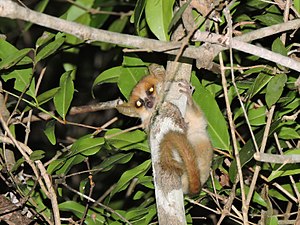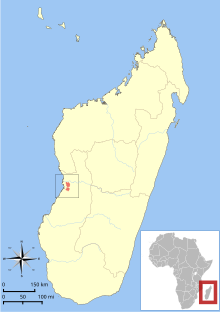Berthe-Mausmaki
| Berthe-Mausmaki | ||||||||||||
|---|---|---|---|---|---|---|---|---|---|---|---|---|

Berthe-Mausmaki ( Microcebus berthae ) |
||||||||||||
| Systematics | ||||||||||||
|
||||||||||||
| Scientific name | ||||||||||||
| Microcebus berthae | ||||||||||||
| Rasoloarison et al., 2000 |
The Berthe-mouse lemurs , also (Madame) Berthes Mausmaki , ( Microcebus berthae ) is an on Madagascar living primate species from the kind of mouse lemurs within the group of lemurs . It is the smallest known primate. The specific epithet honors the Malagasy anthropologist Berthe Rakotosamimanana .
features
Berthe lemurs reach a body length of 9 to 9.5 centimeters, plus a tail 13 to 14 centimeters long. The weight is 24 to 38 grams. Their fur is short and dense, it is reddish-brown on the top and yellowish-white on the underside. The tail is also reddish-brown, it is comparatively long and more densely hairy than that of other mouse lemurs. The head is rounded, it is orange and visibly lighter than the trunk. The muzzle is short, the ears are large. There is a whitish spot between the large eyes.
distribution and habitat

Berthe lemurs are so far only known from the Kirindy Forest and adjacent areas on the west coast of Madagascar. It is not known how far their actual distribution area extends. Their habitat are dry deciduous forests.
Way of life
These lemurs are nocturnal and mostly stay in the trees. During the day they sleep in leaf nests that are attached to lianas and other hanging plants. They inhabit territories of around 1.2 hectares in size, but the territories of the males are larger than those of the females. The territories overlap, but the animals go solitary in search of food.
Berthe lemurs are presumably omnivores, which in addition to fruits and other vegetable material also eat insects. To save energy, they fall into a torpor (rigid state) every day, but not for very long .
Danger
Berthe lemurs are sometimes found in great densities, in places up to 100 animals share a square kilometer. However, its range is small - perhaps no more than 900 km² - and fragmented. The IUCN lists the species as " critically endangered ".
literature
- Nick Garbutt: Mammals of Madagascar. A Complete Guide. Yale University Press, New Haven CT 2007, ISBN 978-0-300-12550-4 .
- Don E. Wilson, DeeAnn M. Reeder (Eds.): Mammal Species of the World . 3rd edition. The Johns Hopkins University Press, Baltimore 2005, ISBN 0-8018-8221-4 .
Web links
- Microcebus berthae inthe IUCN Red List of Endangered Species 2020.2. Posted by: Markolf, M .; Schäffler, L .; Kappeler, P., 2019. Retrieved July 12, 2020.